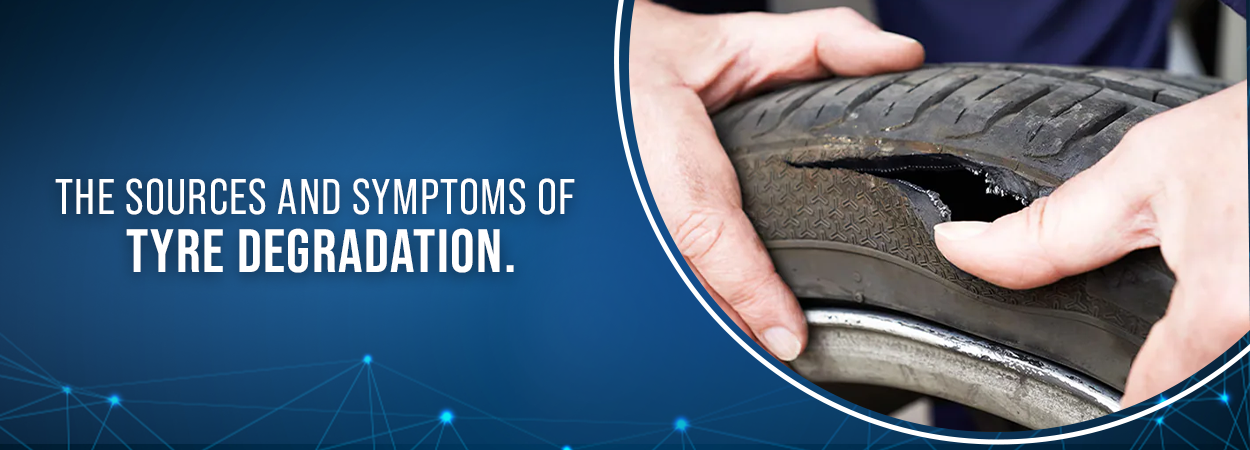Understanding Tyre Deterioration: Typical Forms & Indications


The Sources and Symptoms of Tyre Degradation:
There are many ways that tyres can suffer losses, and often this happens even without the ways that tyres can suffer damage, and often this happens even without the operator immediately recognizing there is a problem. The most common types of damage are piercings, wounds, collisions, breakage, bumps, and random wear. In this section, we’ll describe the symptoms in more detail to help you diagnose the problem. We’ll also offer some advice on how to prevent issues.
Identifying erratic ageing:
There are several types of unusual wear, with heel and toe wear, asymmetrical wear, and concentration wear among the most prevalent types. Below, we describe their origins and mechanisms.
1.Heel and toe wear:
Typical use and suspension settings are two examples of what might cause this wear. It’s the allegedly obvious (and observable) involvement of various distortional forces in the music. How about we delve a little further into the track’s layout to further clarify?
In order to provide safety on flooded and damp roadways, track notches and sipes are essential. In order to uproot the water and increase protection against hydroplaning, low-profile tyres in particular require a greater degree of track void. The shoulder region has unconnected squares that are cross-grooves for water leakage. Under specific operating conditions, a moving growth might cause these shoulder squares to wear into a heel-and-toe and toe pattern.
2. Concentration wear:
High force levels generated during solid acceleration, in stop-and-go city traffic, or while accelerating ceaselessly from stoplights can quickly increase track wear at the tyre’s focus point. Even today’s mid-range cars have motors that are capable of producing significant amounts of force and are suitable for providing increased rates of slip.
3. Irregular wear:
The most common cause of asymmetrical wear is improper hinge math. Variances from the norm might have long-term consequences, such as scaling a wall. Reduced vehicle height because of narrow-profile tyres can also have a negative impact on wheel layout. When driving, adjustable stabilizer arms will often cause the wheel configuration to deviate from the specified position. The issue can make drivers unaware since wheel arrangement esteems can nevertheless be found to be inside resilience limitations when determined in a static situation on a hub estimation seat. Nevertheless, the manufacturer’s arrangement information pertains to automobiles as provided and may not apply to modified vehicles.
Differentiating between an impact fracture and a lump:
An effect break is an injury delivered on the corpse (the tyre packing) once the tyre comes into touch with specified impediments. An articulated outer lump on the tyre’s side depicts destroyed ropes within the body.
This type of injury is typically caused by sliding over objects, such as curbs or obstacles, at excessive speed or at an undesirable location, overemphasizing the body and causing solitary lines to break. The particular amount of injury will be influenced by the velocity and point of action, as well as the size of the barrier.
Careful operators are typically prepared to avoid this type of injury unless a snag appears unexpectedly in front of them and they are unable to redirect around this one. Ignoring such damage increases the risk of tyre dissatisfaction in the long run, either via structural failure of the racetrack and uses or degeneration of the tyre sidewall. An impact gap is sometimes confused with a sidewall space, although they are not the same thing. As we explain below, dents or voids in the sidewall cause concern.
Identifying a sidewall depression:
A tyre sidewall depression is not always completely even; there may be wrinkles and gaps that demand a more detailed examination to determine its source. The most important thing to understand is that spaces are not harmful to either mobility or very well traits. The eddies are not deep. Holes in the tyre are best defined by imagining tying a string around a swollen inflated and then delicately tugging the rope tight. If the inflatable is the tyre, the thread is the inserted body strands that are concealed by the flexible. There are usually a handful of coverings in the body when building a tyre – instead of creating the corpse to which the steel belt and track are attached. This cover is what is seen as a gap after the tyre has been installed and expanded. Nonetheless, if you are unsure, have the sidewall gaps examined by a trained tyre technician.
Takeaway:
Motorists can achieve consistent tyre wear by regularly swapping the tyres from the head to the quasi-hub. Nonetheless, if you don’t care, take note of the car manufacturer’s instructions.
If you find yourself in a situation where you need to drive over a deterrence in the street, approach it cautiously and as close to the opposite as possible. Check your tyres for exterior damage, such as cuts, fractures, or lumps, a short time afterwards. Also, avoid driving aggressively on dirt roadways.
FAQs:
1. What types of tyre degradation are popular?
Tires may be ruined for a wide range of reasons, and this can happen without the driver being mindful of the issue. Perforations, scratches, collisions, fractures, lumps and bumps, and uneven wear are the most prevalent kinds of damage.
2. What is the most common reason for tyre failure?
Underinflation is a major cause of tyre failure. Inadequately tyres flex more in the sidewall. They heat up well above optimal working degrees because of extra twisting. This difficulty is exacerbated while travelling at cruising speeds for a prolonged period on warmer days.
